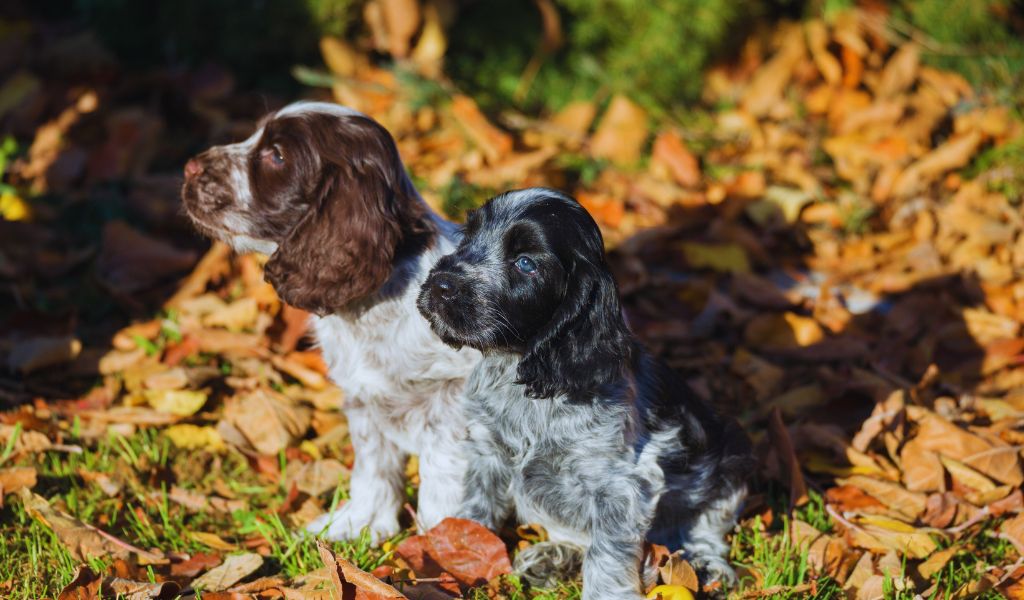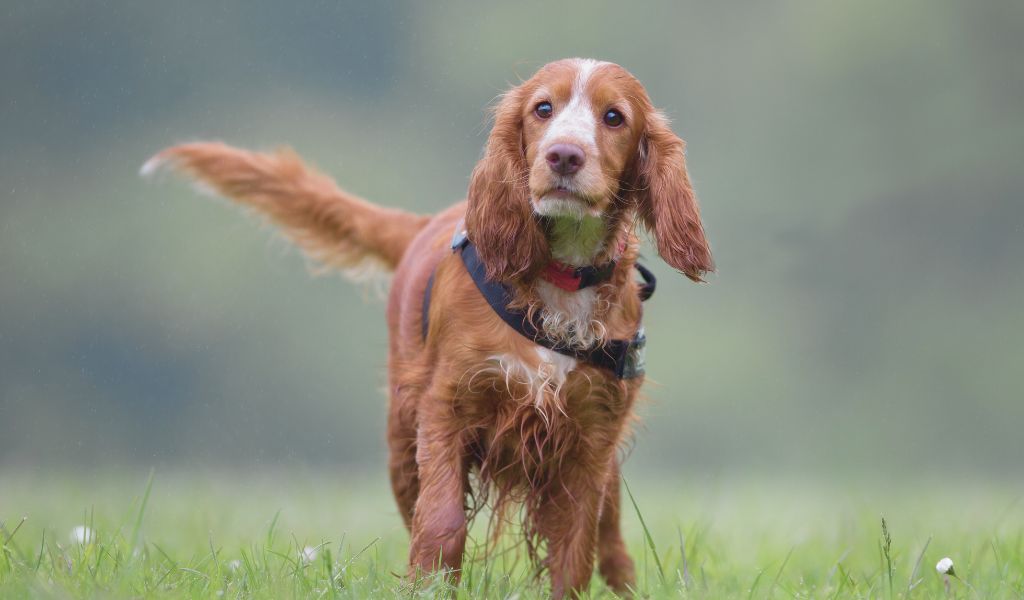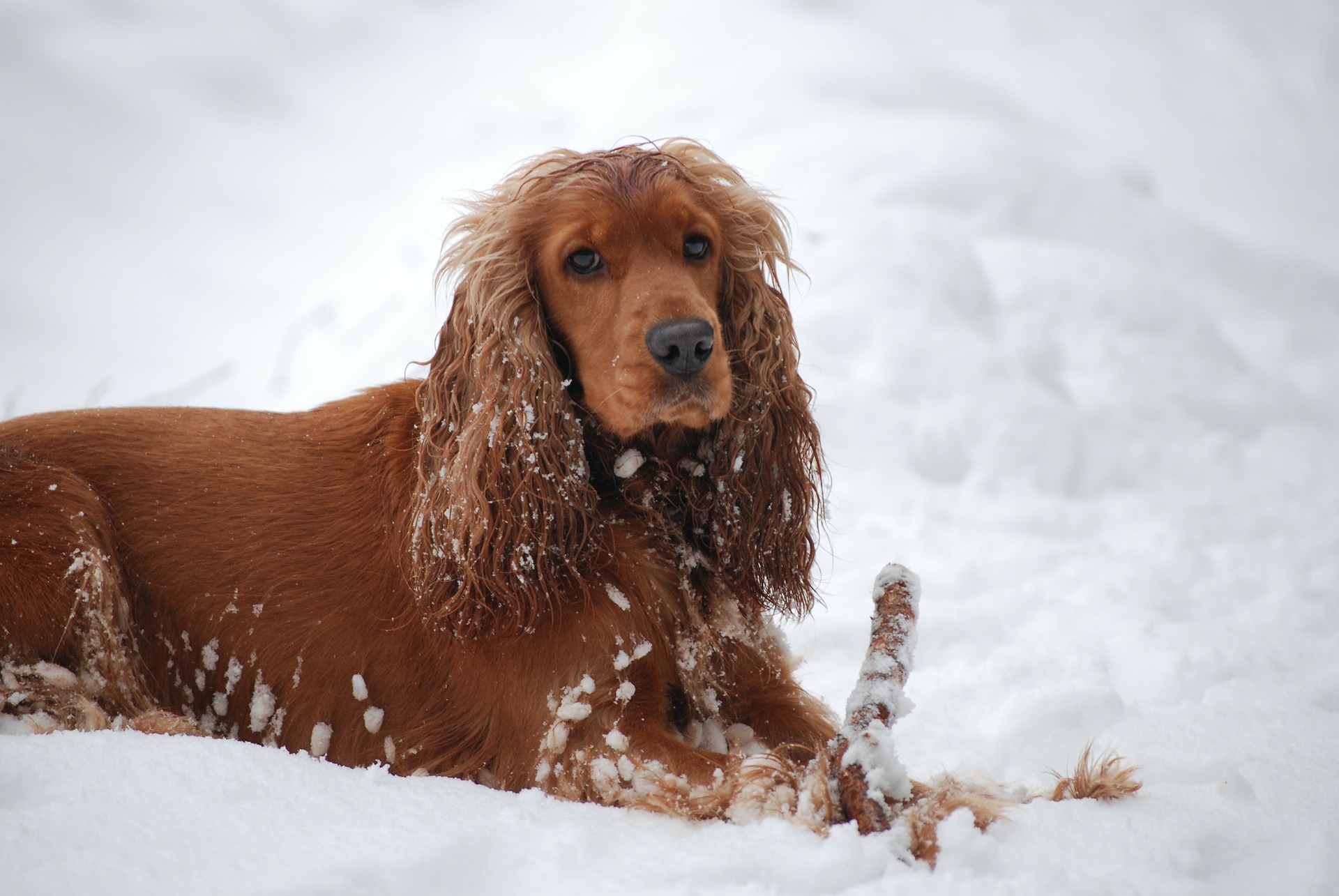So, do Cocker spaniels need coats? It will depend on where you live and the weather and temperature outside. You’ll need to provide your dog with a good coat if it is cold and wet. So, yes, Cocker Spaniels do need coats.
Cocker spaniels are hardy dogs that have been bred for days outside, working and they enjoy being outdoors for long periods.
Like all animals, they can get cold, particularly if the weather is damp or wet, the temperature is low and if they are stationary for long periods and it is important to protect them from adverse conditions.
My two Cocker spaniels, Boris and Nimrod, and others that I have been around do seem to get cold more quickly than other breeds of spaniels that I have owned. So they have coats to give them some protection, and these do help.

What type of coat does a Cocker spaniel have?
Cocker spaniels have short to medium length coats that normally have areas of feathering around the chest and legs.
Their hair is generally fine and silky, although if the Cocker has been shaved in the past then his hair will be more wiry.
Underneath the ‘top coat’ of fine and silky hair, there is another layer which we can describe as an undercoat.
This is a soft coat which provides your dog with insulation to help to keep him warm.
This soft ‘inner coat’ is one of the reasons why many people say you should not roughly towel dry a spaniel as you will force water into the undercoat, which will make him cold.
It is also one of the reasons why should not bath your Cocker Spaniel too often as you remove the natural oils that help to repel moisture.
Should I get a winter coat for my Cocker spaniel?
This really depends on where you live, the temperature, whether you dog gets wet when you go out and, to some extent, how old and healthy your spaniel is.
The double coat that Cocker spaniels have is designed to keep them warm, however, it is only thin and will only provide your dog with protection for a short period of time.
Whereas his coat is better than the coat of a poodle, it is not as effective as that of a husky or similar dog.
If you live in a cold or wet ( or both) area, then it is wise to get your Cocker spaniel a coat, this will help to keep him warm and happy and will also help to minimise any potential health problems that could occur with him getting cold.
Is putting a coat on my spaniel cruel?
I’m not an advocate of putting clothes on spaniels or, for that matter any other breed of dog. I’m of the view that dogs are dogs and should be allowed to be dogs, they are not mini people.
That said many people do dress their dogs up in a variety of outfits and the dogs don’t seem to suffer from it.
As for being cruel? I don’t know, but there are certainly far more worse things that people do to dogs which are definitely cruel.
If your spaniel gets too cold then he can become very unwell and if a coat helps to prevent this and keep your Cocker spaniel warm and comfortable then it is worth using.
Can Cocker spaniels get hypothermia?
If your Cocker spaniel gets very cold then this can result in hypothermia.
Your spaniel’s normal body temperature will be between 101 degrees fahrenheit and 102.5 degrees. Anything below 100 degrees is considered to be hypothermia in dogs.
If this persists and is not dealt with quickly then it can cause serious complications and can even be fatal.
You will know if your spaniel is feeling cold as he will likely be shivering, the inside of his ears will be cold to the touch and his gums may look pale.
If he isn’t warmed carefully then he may become listless and lethargic.
The key causes of hypothermia are:
Being exposed to low temperatues for long periods of time
Being in winds or draughts – this can even occur on a warm day
Wet hair/fur and skin
Being in cold water or icy conditions (snow) for long periods of time
What to do if your Cocker spaniel gets really cold
If your Cocker spaniel gets excessively cold, then you should look to turn this around and help him to feel warm. The longer that you leave it the worse it could become.
Warm some blankets, towels, sheets, anything you can find, either in the dryer, on a radiator, with a hairdryer – however you are able.
Wrap your dog in the warm blankets
Fill a hot water bottle with hot water, wrap it inside a towel and place it carefully against your spaniel’s tummy.
Move your dog to a warm area
Make sure that he is dry and away from any draughts
Contact your vet for professional advice if you are concerned
How to stop your Cocker spaniel from getting cold
The best way to stop your spaniel from getting cold is to avoid spending too much time in cold and wet conditions with your dog.
If you are out while the weather is like this then keep your spaniel moving, he will generate body heat from running or walking.
If you stay still while he is wet then he will quickly get cold – just like you do.
If your spaniel is old or has health conditions then the risk of getting cold can increase and you should be thoughtful about how long you spend in the cold and wet with him.
Dog coats, boots and other dog clothing can help to keep your Cocker spaniel warm and dry particularly during the winter months.
Do Cocker spaniels like rain?
Based on the information I gathered during my research, the response of Cocker spaniels to rain varies among individual dogs.
Some Cocker spaniels avoid puddles and dislike getting wet or muddy, while others seem to be attracted to mud, puddles, and bodies of water. For instance:
One owner mentioned their Cocker spaniel, Smudge, would avoid puddles and detour around them, also disliking washing paws in water.
Another Cocker spaniel, Floyd, initially avoided puddles and mud but eventually started to head straight for them.
Tilly, another Cocker spaniel, is a puddle-avoider and dislikes rain to the extent of not wanting to go out even for a wee.
Mollie loves mud and bodies of water but refuses to go out in the rain.
Some owners observed their Cocker spaniels running around trying to get away from their wet selves after walking in the rain.
Another example is Gari, who enjoys lying in puddles but hates getting a shower.
It appears that while some Cocker spaniels may enjoy playing in water and getting muddy, they might not necessarily enjoy the rain itself, often showing an aversion to going out in it.
This behaviour seems to be more about individual preferences rather than a breed-specific trait.

What is the best coat to get for a Cocker spaniel?
There are a number of things to consider before you buy a coat for your Cocker spaniel:
The size of the coat – you need to make sure that you get the right sized coat for your spaniel so that it fits properly and keeps him warm and dry.
The ideal dog coat should fit well but should have enough room and freedom to give your dog the opportunity to move around easily.
The coat will need to cover the main areas of his body that will be exposed to the weather – his chest and neck, his back, and some of his tummy.
Most suppliers provide guides to help you to measure your dog before you order so that you can get the correct size.
My Cockers have coats from the middle isle of Aldi – which were cheap, but well made and are durable – great value for working spaniels that often get filthy.
Here are some alternative options, that are great for Cockers:
Things to look for
Can you wash it? – Your spaniel’s coat will get dirty quite quickly, most likely from mud and dirty water.
It can also get grubby from snow and slush and there is a good chance that it will end up with urine on it from when he goes to the toilet.
So before you buy check to see if the coat can be easily washed, either by hand or in the machine.
Is it waterproof? – at the very least any coat for your Cocker Spaniel should be water resistant but ideally you need a coat to be waterproof.
If a coat cannot withstand the rain and damp then it will quickly allow water onto your dog’s skin and he will get cold. You need a coat that keeps your dog warm and dry.
How well insulated is it? – To keep your spaniel warm you will need a coat that is well insulated.
Check the coat to see what the insulataion is made from, most coats contain synthetic materials and fleece that will keep your spaniel warm.
Can he go to the toilet easily? – Your spaniel will need a coat that allows him to go to the toilet when he needs to.
A coat that needs removing or prevents him from going is no real use to him. Most coats have openings that are conveniently placed.
How heavy is it? – You’ll need to find a coat that offers the best combination of weight and weather protection and insulation.
A coat that is too heavy for your spaniel will be ineffective and uncomfortable for him, whereas one that is lightweight will offer little protection in harsh weather and environments.
FAQs
Do Cocker spaniels need coats during the winter months?
During the winter months, it is important to consider whether Cocker spaniels need coats to stay warm.
While Cocker spaniels have a thick double coat that provides some insulation, they may still benefit from wearing a coat in extremely cold temperatures or in areas with harsh weather conditions.
It is especially important to protect them if they spend a lot of time outdoors or if they have a shorter coat. However, it’s important to note that not all Cocker spaniels will require coats, as individual tolerance to cold can vary.
Are there any specific considerations when choosing a coat for a Cocker spaniel?
When selecting a coat for your Cocker spaniel, there are a few factors to keep in mind. First and foremost, ensure that the coat fits properly and allows for comfortable movement.
Look for coats that are specifically designed for dogs and offer insulation and water resistance. It’s also a good idea to choose a coat with reflective materials for added visibility, especially during evening walks.
Additionally, consider the ease of cleaning and maintenance, as Cocker spaniels can have a tendency to get dirty easily.
How can I tell if my Cocker spaniel is too cold or in need of a coat?
Cocker spaniels, like all dogs, have their own unique cold tolerance. It’s essential to pay attention to their behaviour and body language to determine if they are too cold or in need of a coat.
Signs of discomfort or being too cold can include shivering, seeking warmth by curling up or seeking shelter, or appearing lethargic. If you notice any of these signs, it may be a good idea to consider providing your Cocker spaniel with a coat for added warmth and protection.
However, it’s always a good idea to consult with your veterinarian for personalised advice based on your dog’s specific needs.
All dogs can get cold and Cockers are no exception.
It’s worth considering a coat for your dog for bad weather conditions or for a dog that is elderly or unwell.
Most dog coats are reasonably priced and durable and offer good levels of weather protection to help your dog to stay comfortable.




